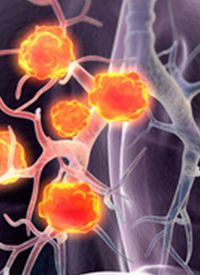Article
Repotrectinib Receives Breakthrough Therapy Designations in China for ROS1+ NSCLC
Author(s):
The China National Medical Products Administration’s Center for Drug Evaluation granted 2 breakthrough therapy designations to repotrectinib for the treatment of patients with ROS1-positive metastatic non–small cell lung cancer.

The China National Medical Products Administration’s Center for Drug Evaluation (CDE) granted 2 breakthrough therapy designations to repotrectinib for the treatment of patients with ROS1-positive metastatic non–small cell lung cancer (NSCLC).1
The first designation is for those who received 1 prior line of treatment with a ROS1 TKI and 1 prior line of platinum-based chemotherapy, and the second designation was for those who have received 1 prior line of treatment with a ROS1 TKI and no chemotherapy or immunotherapy.
The designations were supported by findings from the phase 1/2 TRIDENT-1 trial (NCT03093116) in Chinese patients with ROS1-positive NSCLC who were pretreated with a TKI.
“Since repotrectinib received breakthrough therapy designation by the CDE earlier this year for ROS1-positive, TKI-naïve patients, [this] recognition further supports repotrectinib as a potential best-in-class treatment for ROS1-positive NSCLC in both TKI-naïve and pretreated patients in China,” Alan Sandler, MD, president and head of Global Development, Oncology, at Zai Lab Limited, stated in a press release. “There remain significant unmet needs for [patients with] ROS1-positive NSCLC, and we look forward to our continued partnership with regulatory authorities in China to bring this important medicine to patients in need as soon as possible.”
In May 2022, the FDA granted repotrectinib a breakthrough therapy designation for the treatment of patients with ROS1-positive metastatic NSCLC who have been previously treated with 1 ROS1 TKI and who have not received prior platinum-based chemotherapy.2
The FDA’s designation was also based on data from TRIDENT-1. TRIDENT-1 included 6 expansion cohorts: ROS1 TKI–naïve ROS1-positive NSCLC (cohort 1), ROS1-positive NSCLC with 1 prior ROS1 TKI and 1 platinum-based chemotherapy regimen (cohort 2), ROS1-positive NSCLC with 2 prior ROS1 TKIs (cohort 3), ROS1-positive NSCLC with 1 prior ROS1 TKI (cohort 4), TRK TKI–naïve NTRK-positive solid tumors (cohort 5), and TRK TKI–pretreated NTRK-positive solid tumors (cohort 6).
The co-primary end points of the first phase of the trial included observing dose-limiting toxicities and establishing a recommended phase 2 dose for the agent. Secondary end points included safety, pharmacokinetics, and preliminary antitumor efficacy.
The primary end point of the phase 2 portion of the research was objective response rate (ORR), and secondary end points included duration of response (DOR), clinical benefit rate, progression-free survival, overall survival, and intracranial ORR.3
Interim data from the expansion 2 cohort showed that among 5 patients with ROS1-positive NSCLC who were pretreated with 1 prior TKI and chemotherapy, 2 patients achieved a confirmed response, which translated to an ORR of 40%.4 The DOR achieved with the agent ranged from 4.5 months to 5.6+ months.
Additionally, interim data from the expansion 4 cohort demonstrated that among 6 patients with ROS1-positive NSCLC who received prior treatment with 1 TKI without chemotherapy, 4 achieved a confirmed response, which translated to an ORR of 67%. The DOR ranged from 1.0+ months to 5.7+ months. Notably, all 4 patients continued to respond to treatment with repotrectinib at the time of data cutoff.
Pooled safety data from patients in all cohorts in phase 1 and phase 2 of TRIDENT-1 (n = 185) showed that most treatment-related adverse effects (TRAEs) were grade 1 or 2, and none were greater than grade 3 in severity.5
Furthermore, most treatment-emergent AEs (TEAEs) were grade 1 (79%). The most common TEAE of any grade was low-grade dizziness (58.4%), which did not lead to treatment discontinuation. Dose reductions occurred in 17.8% of patients due to TEAEs, and 8.6% of patients discontinued treatment because of TEAEs.
References
- Zai Lab announces breakthrough therapy designations granted for repotrectinib in China. News release. Zai Lab Limited. June 10, 2022. Accessed June 17, 2022. https://bit.ly/3HzeX6L
- Turning Point Therapeutics granted breakthrough therapy designation for repotrectinib treatment in patients with one prior ROS1 tyrosine kinase inhibitor and no prior chemotherapy. News release. Turning Point Therapeutics, Inc. May 10, 2022. Accessed June 17, 2022. https://bit.ly/3wiwZVv
- A study of repotrectinib (TPX-0005) in patients with advanced solid tumors harboring ALK, ROS1, or NTRK1-3 rearrangements (TRIDENT-1). ClinicalTrials.gov. Updated June 3, 2022. Accessed June 17, 2022. https://clinicaltrials.gov/ct2/show/NCT03093116
- Turning Point Therapeutics reports early interim data from registrational phase 2 Trident-1 study of repotrectinib, provides regulatory update. News release. Turning Point Therapeutics. August 19, 2020. Accessed June 17, 2022. https://bit.ly/3iV1w3h
- Cho BC, Doebele RC, Lin J, et al. Phase 1/2 TRIDENT-1 study of repotrectinib in patients with ROS1+ or NTRK+ advanced solid tumors. J Thorac Oncol. 2021;16(3):S174-S175. doi:10.1016/j.jtho.2021.01.251









